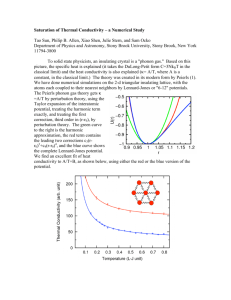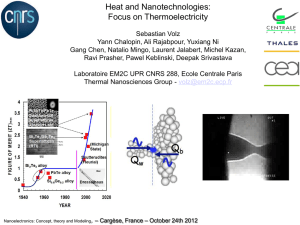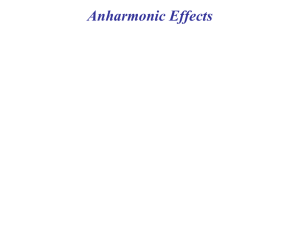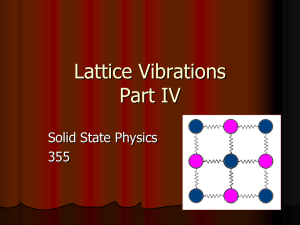Microscopic mechanism of low thermal conductivity in lead telluride Please share
advertisement
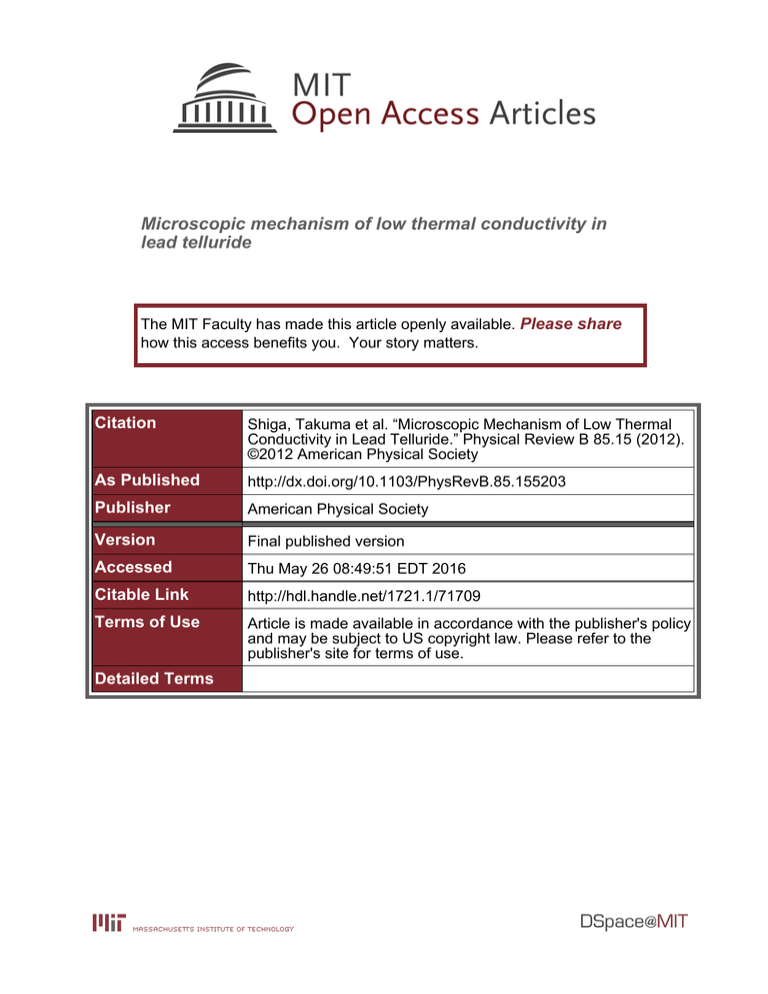
Microscopic mechanism of low thermal conductivity in lead telluride The MIT Faculty has made this article openly available. Please share how this access benefits you. Your story matters. Citation Shiga, Takuma et al. “Microscopic Mechanism of Low Thermal Conductivity in Lead Telluride.” Physical Review B 85.15 (2012). ©2012 American Physical Society As Published http://dx.doi.org/10.1103/PhysRevB.85.155203 Publisher American Physical Society Version Final published version Accessed Thu May 26 08:49:51 EDT 2016 Citable Link http://hdl.handle.net/1721.1/71709 Terms of Use Article is made available in accordance with the publisher's policy and may be subject to US copyright law. Please refer to the publisher's site for terms of use. Detailed Terms PHYSICAL REVIEW B 85, 155203 (2012) Microscopic mechanism of low thermal conductivity in lead telluride Takuma Shiga,1 Junichiro Shiomi,1,2,* Jie Ma,3 Olivier Delaire,3 Tomasz Radzynski,4 Andrzej Lusakowski,4 Keivan Esfarjani,5 and Gang Chen5 1 Department of Mechanical Engineering, The University of Tokyo, Hongo Bunkyo-ku, Tokyo, 113-8656, Japan 2 Japan Science and Technology Agency, PRESTO, 4-1-8 Honcho, Kawaguchi, Saitama, 332-0012, Japan 3 Neutron Scattering Science Division, Oak Ridge National Laboratory, 1 Bethel Valley Road, Oak Ridge, Tennessee 37831, USA 4 Institute of Physics, Polish Academy of Sciences, Warsaw, Poland 5 Department of Mechanical Engineering, Massachusetts Institute of Technology, 77 Massachusetts Avenue, Cambridge, Massachusetts 02139, USA (Received 16 December 2011; revised manuscript received 10 March 2012; published 10 April 2012) The microscopic physics behind low-lattice thermal conductivity of single-crystal rock salt lead telluride (PbTe) is investigated. Mode-dependent phonon (normal and umklapp) scattering rates and their impact on thermal conductivity were quantified by first-principles-based anharmonic lattice dynamics calculations that accurately reproduce thermal conductivity in a wide temperature range. The low thermal conductivity of PbTe is attributed to the scattering of longitudinal acoustic phonons by transverse optical phonons with large anharmonicity and small group velocity of the soft transverse acoustic phonons. This results in enhancing the relative contribution of optical phonons, which are usually minor heat carriers in bulk materials. DOI: 10.1103/PhysRevB.85.155203 PACS number(s): 66.70.Df, 63.20.dk, 63.20.kg, 65.40.G− I. INTRODUCTION The energy conversion efficiency of semiconducting thermoelectric materials is characterized by the dimensionless figure of merit ZT = S 2 σel T /(κel + κlat ), where S, σel, κel , κlat , and T are the Seebeck coefficient, electrical conductivity, electron thermal conductivity, lattice thermal conductivity, and temperature, respectively.1 Strategies to suppress κlat without critically deteriorating the other properties have been shown to be effective to enhance ZT . This includes alloying species with mass mismatch to enhance mass-difference phonon scattering,2 filling with rattling ions to scatter phonons in cage compounds,3,4 or embedding layered structures to reduce the phonon group velocity and/or enhance intrinsic phonon scattering.5 These approaches are complementary to recently developed nanostructuring techniques6,7 to improve the starting-material properties. While these intuitive approaches rely on the inhomogeneity or complexity of crystals, there are bulk materials with simple structures that show low thermal conductivity. Rock salt lead telluride (PbTe) is a prime example among thermoelectric materials that has been long known to exhibit low thermal conductivity (∼2 Wm−1 K−1 at 300 K) despite its high symmetry and coordination. PbTe is one of the most promising thermoelectric materials for applications in the intermediate temperature range (400– 800 K) due to its low κlat , as well as high S and σel when appropriately doped.8–10 The counterintuitively low thermal conductivity of PbTe has been discussed based on phonon dispersion relations either calculated from first principles11,12 or measured by inelastic neutron scattering (INS).13 The first principles calculations have shown that the energy of the transverse optical (TO) phonons near the zone center ( point) is highly sensitive to changes in volume,11,12 and this led researchers to conjecture a strong coupling between TO and longitudinal acoustic (LA) phonons since they are compressive waves. More recently, INS measurements13 have probed aspects, such as the avoided crossing of LA and TO branches and the complex peak broadening in INS intensity 1098-0121/2012/85(15)/155203(5) of TO modes near point, which, through momentum and energy conservation arguments and mode-coupling theory, are suggested to be due to strongly anharmonic LA-TO coupling. While the idea of strong LA-TO scattering may be plausible, the arguments so far remain phenomenological without quantitative knowledge of the actual scattering rates of the processes. In addition, it is not clear how strong the LA-TO scattering is compared with other scattering processes and how much it influences the overall thermal conductivity. In this paper, we answer these questions by calculating the scattering rates of all the three-phonon processes occurring in PbTe using the framework of first-principles-based anharmonic lattice dynamics (ALD), which has been applied successfully to simple monoatomic crystals14–16 and relatively complex compounds.17 II. METHODOLOGY To examine the anharmonic phonon dynamics, it is important to obtain accurate anharmonic interatomic force constants (IFCs), which are here defined as the Taylor expansion coefficients of the force, with respect to atomic displacements from equilibrium configurations, αβ 1 αβγ ij uj,β − uj,β uk,γ , (1) Fi,α = −i,α − 2 j k,βγ ij k j,β αβ αβγ where ij and ij k are harmonic and cubic anharmonic IFCs, respectively. The indices i, j , and k are the atom indices, and α, β, and γ denote the Cartesian components. In this study, the IFCs of a rock salt PbTe were computed following the real-space displacement method,18 with the Hellman–Feynman forces calculated by density functional theory (DFT) in a 2 × 2 × 2 conventional supercell with 64 atoms. In the real-space displacement method, sets of forcedisplacement data are obtained by systematically displacing one or two atoms at a time about their equilibrium position 155203-1 ©2012 American Physical Society TAKUMA SHIGA et al. PHYSICAL REVIEW B 85, 155203 (2012) along Cartesian coordinates. Here, the atoms were displaced by ± 0.01 and ± 0.02 Å. Then Eq. (1) can be fitted to the force-displacement data, together with the symmetry properties, translational/rotational invariance conditions, by using a singular value decomposition algorithm to obtain harmonic and cubic IFCs.18 The ranges of IFCs (number of neighboring shells that interact with a given atom) were chosen to be respectively six and one for harmonic and cubic IFCs to minimize the fitting residual, while keeping the computation affordable. While the method could in principle work with any number of force-displacement data due to its fitting nature, in the current work, displacements were performed for all the irreducible degrees of freedom by taking the symmetry into account. We have used the Quantum Espresso package19 for the DFT calculations. The norm conserving pseudopotential was designed to incorporate relativistic effects. We find that incorporation of the spin-orbit coupling is important to assure the level of accuracy in the calculated thermal conductivity presented later. A 5 × 5 × 5 Monkhorst–Pack k-point mesh20 was used to sample electronic states in the first Brillouin zone, and an energy cutoff of 50 Ryd (∼650 eV) was used for the plane-wave expansion. The lattice constant was set to 6.548 Å, which was found to minimize the ground state total energy. The Perdew-Burke-Ernzerhof functional was used to describe the exchange-correlation effects. Using the harmonic IFCs, the phonon dispersion relations can be readily calculated through the dynamic matrices.21 Note that, since PbTe is a polar crystal, the effect of ionic charges needs to be considered. This was modeled for simplicity by adding the nonanalytical term22 to the dynamical matrix with the Born effective charges and dielectric constant Z∗Pb = +5.87, Z∗Te = −5.87, and ε∞ = 38.48, which were calculated through macroscopic electric polarization using the density functional perturbation theory.23 III. RESULTS AND DISCUSSION This work W. Cochran, et al., (1966) 4 16 2 8 0 0 TO Frequency (meV) Frequency (THz) The phonon dispersion relations of PbTe are shown in Fig. 1(a). The calculations reproduce the overall features of the Gruneisen parameter 10 0 Γ X K Γ L FIG. 1. (Color online) (a) Phonon dispersion relations of PbTe along -X-K--L symmetry lines. Red open and blue filled circles indicate transverse and longitudinal modes, respectively, from inelastic neutron scattering (INS) experiments at 300 K.24 (b) The mode-Grüneisen parameters. phonon dispersion relations obtained by the INS experiments24 with particularly good agreement for the acoustic phonons, which are important as they are the main heat carriers. One noticeable feature is that the acoustic branches, particularly the TA branches, are very soft. For instance, the group velocity of the long-wave TA modes along the [100] direction is 1185 m/s, comparable to the group velocity of van der Waals systems, such as solid argon.25 Such slow propagation speed of active carriers is expected to limit the contribution of TA phonons to the overall thermal conductivity. It can be noticed that the discrepancy between the calculated and experimental dispersion relations is larger for optical phonons, particularly for the LO branch, which splits from the TO branch at the point due to the ionic charge effect. The discrepancy at the point is due to the difference in the Born effective charges and dielectric constants, which in this work were calculated for ground states, and the discrepancy in the line shapes of the phonon dispersion relations away from is due to the excess simplification of the nonanalytical term.22 Therefore, the sensitivity of the results to the discrepancy was checked by tuning the Born effective charges and dielectric constants to match the LO frequency at with that of the experiment, and the changes in the calculated acoustic phonon scattering rates and κlat were confirmed be less than 1%. The cubic IFCs enable us to compute the mode Grüneisen parameters, which is a useful measure of the anharmonicity of the crystal. As shown in Fig. 1(b), the mode Grüneisen parameters of TO phonons exhibit a diverging trend upon approaching the point. This has been discussed to cause significant softening of near- TO modes.11,12 The result indicates that dynamics of TO phonons near point is extremely anharmonic, which is expected to enhance their scattering rates with the acoustic phonons and thus affect the thermal conductivity. With the eigenstates and cubic Hamiltonian, the self-energy qs of phonons can be calculated by the anharmonic lattice dynamics (ALD) approach,26 where q and s denote the wave vector and phonon branch, respectively. Here, we only take into account the three phonon (normal and umklapp) scattering processes, which are the dominant source of intrinsic thermal resistance.21 The calculation is based on Fermi’s golden rule of the phonon-scattering processes that satisfy the energy and momentum conservation, with phonon generation and annihilation operators derived using the cubic IFCs. The calculations were done for Nq × Nq × Nq uniform reciprocal meshes. The imaginary part of the self-energy gives the phonon scattering rate wqs , which is inverselyproportional to the phonon relaxation time, τqs [wqs = 2Im( qs ) = 1/τqs ]. It was confirmed that the calculated phonon scattering rates were well converged with Nq = 20. Figure 2(a) shows the frequency dependence of phonon relaxation time at 300 K calculated by ALD with Nq = 20. The phonon relaxation times of acoustic branches exhibit inverse quadratic dependence on frequency (τ ∝ν −2 , where ν is frequency) in the low-frequency region, in agreement with Klemens’s prediction.27 In this low-frequency region, where the active heat carriers reside, the phonon relaxation times of TA phonons are longer than those of LA phonons. We can further separate the scattering rates into those of normal and 155203-2 MICROSCOPIC MECHANISM OF LOW THERMAL . . . 1 Umklapp τ∝ ν –3 –1 T=400 K T=600 K 1 0.05 0.1 1/Nq 0 100 This work Ravich (1970) Sootsman, et al.,(2006) 300 500 700 Τ (K) –1 Τ=300 K, Nq=20 1 TA –1 –1 2 0 2 100 10 T=300 K κcumlative (Wm K ) 10 (c) 4 N –2 1 TA TA LA TO TO LO (b) –1 10 τ∝ ν –1 Relaxation time (ps) 100 τ∝ ν –2 (a) 6 Normal κlat (Wm K ) (b) 100 κlat (Wm K ) (a) PHYSICAL REVIEW B 85, 155203 (2012) 900 TA ave LA 0.5 TO ave 0 1 TO LO 100 Λ0 (nm) 1 0.1 1 Frequency, ν (THz) 0.1 1 FIG. 2. (Color online) (a) Frequency-dependent phonon relaxation times of PbTe at 300 K by anharmonic lattice dynamics (ALD) calculations with Nq = 20. Frequency-dependent phonon relaxation times of (b) normal and (c) umklapp processes, respectively. The solid lines denote (a) τ = 6 × 1012 ν −2 , (b) τ = 8.0 × 1012 ν −2 , and (c) τ = 8.0 × 1024 ν −3 . umklapp processes, as shown in Figs. 2(b) and 2(c). The results clearly identify the scalings for normal process, τnormal ∝ ν −2 , and umklapp process, τumklapp ∝ ν −3 , which have been derived by Esfarjani et al.16 as leading-order relations in the low-frequency limit. The results show that the scattering rate of normal processes is larger in the low-frequency region; and this, through the Matthiessen’s rule,21 gives rise to the inverse quadratic frequency dependence of the overall phonon relaxation time. Let us now look into the wave number dependence of the scattering rate wqs along a representative (-X) symmetry line. Figures 3(a) and 3(b) show wqs of acoustic and optical phonons, respectively, at 300 K calculated with Nq = 20. The results show that wqs of LA phonon is significantly larger than that of the TA phonon for a given wave number along -X, which is consistent with the overall feature of phonon relaxation time shown in Fig. 2. The scattering rates of the LA phonons along -X are now compared with those extracted from the INS experiment.13 In the experiment, wqs 0.4 0.2 (b) 2.5 Experiment wqs (THz) wqs (THz) (a) 0.6 LA 2 1.5 1 TA 0.5 0 0 TO 0.2 0.4 0.6 0.8 1 Wavenumber, q 0 0 LO 0.2 0.4 0.6 0.8 1 Wavenumber, q FIG. 3. (Color online) The scattering rate wqs of (a) acoustic and (b) optical phonons along -X line at 300 K calculated by ALD with Nq = 20. The squares in (a) denote wqs of LA phonons at 300 K from INS experiments.13 The wave number q is normalized by the wave number of X point. FIG. 4. (Color online) (a) Comparison between the temperaturedependent bulk thermal conductivity κlat of PbTe obtained by the ALD calculations (square) and the experiments [circles (Ref. 28) and dashed line (Ref. 29)]. The inset figure shows the extrapolation of N κlatq performed to obtain the bulk thermal conductivity κlat at different temperatures. (b) Cumulative thermal conductivity κc as a function of mean free path (MFP) at 300 K calculated by ALD with Nq = 20. TAave denotes the averaged values of the two TA branches. is obtained by fitting the line shape with a Gaussian function and extracting the line width, corrected for the instrument q-(wave vector) and E-resolution (energy), as well as the slope of the dispersion. The full-width-at-half-maximum value then corresponds to the scattering rate. As shown in Fig. 3(a), the results of the calculations and experiments exhibit reasonable agreement, particularly for the intermediate wave numbers. The calculation gives smaller wqs than the experiments for smaller wave numbers, presumably due to the absence of the avoided crossing in the calculations. The results of optical phonon scattering rates also show high polarization dependence as shown in Fig. 3(b). A noticeable feature is that wqs of TO phonon increases as q approaches the point, which is consistent with the above-mentioned divergence of the mode-Grüneisen parameter. Using the obtained phonon relaxation times, κlat was calculated based on the relaxation time approximation of the phonon gas,26 N κlatq = 1 1 cqs v2g,qs τqs = cqs υg,qs qs , 3 qs 3 qs (2) where cqs , vg,qs , and qs are the specific heat, group velocity vector, and mean free path (MFP) of phonon qs, respectively. Since the calculation was done for discretized mesh points, one needs to account for the size effect due to the missing contribution of long wavelength acoustic phonons.16,17 For N this, as shown in Fig. 4(a), κlatq was calculated for several values of Nq , and κlat (bulk lattice thermal conductivity) was obtained by extrapolating the data using the scaling of the size N effect, κlatq ∝ Nq−1 .16,17 From the extrapolation, it can also be noted that the discrete-mesh calculation with Nq = 20 recovers nearly all the phonons that contribute to κlat . As a result, the temperature dependence of the extrapolated κlat is in excellent agreement with the two experimental results28,29 in a wide temperature range (100–900 K). The quantitative agreement ensures the accuracy of the current first-principles-based ALD methodology. The agreement in the high-temperature region 155203-3 TAKUMA SHIGA et al. PHYSICAL REVIEW B 85, 155203 (2012) TABLE I. The impact of various scattering processes on wq LA for q = 0.1, 0.2, and 0.5 at 300 K. Partial scattering rates (THz) were calculated for (1) scattering with only acoustic phonons, (2) scattering involving at least one TO phonon, and (3) scattering involving at least one LO phonon. The fractions in parentheses are normalized by wq LA , and thus the overall sum exceeds 100% since the categories are not mutually exclusive but remains below ∼110%. Partial scattering rates of LA phonon along -X (THz) Scattering processes (1) Only acoustic (2) TO involved (3) LO involved q = 0.1 q = 0.2 q = 0.5 0.025 (29.6%) 0.045 (19.8%) 0.087 (28.9%) 0.053 (61.5%) 0.144 (63.4%) 0.122 (40.3%) 0.014 (16.2%) 0.056 (24.8%) 0.127 (42.1%) assures the validity of the approximation to incorporate IFCs up to the cubic terms in Eq. (1). Having the microscopic information of phonon transport, we are able to break down the thermal conductivity into contributions from different phonon branches. This was done in terms of cumulative thermal conductivity κc , which is defined as a summation of thermal conductivity up to MFP of 0 ,30 κc (0 ) = qs <0 1 c(ωqs )υqs qs . 3 qs (3) Figure 4(b) shows the κc at 300 K calculated by ALD with Nq = 20. The range of LA phonon MFPs with noticeable contribution to κlat is limited (up to about 10 nm), even similar to those of optical modes. This is much smaller than that of TA phonons (exceeding 100 nm), reflecting the difference in the scattering rates observed in Figs. 2 and 3(a). On the other hand, since the group velocity of long-wave TA phonons are much smaller than that of LA phonons, the average thermal conductivity contribution per branch ends up being similar for LA and TA modes. To understand the cause of this unusually large LA phonon scattering, we have identified the phonon modes that are involved in the scattering of LA phonons at representative wave * shiomi@photon.t.u-tokyo.ac.jp H. J. Goldsmid, Introduction to Thermoelectricity (Spinger, New York, 2009). 2 A. Majumdar, Science 303, 777 (2004). 3 D. J. Braun and W. Jeitschko, J. Less-Common Met. 72, 147 (1980). 4 G. A. Slack and V. G. Tsoukala, J. Appl. Phys. 76, 1665 (1994). 5 K. Koumoto, I. Terasaki, T. Kajitani, M. Ohtaki, and R. Funahashi, in Thermoelectrics Handbook: Macro to Nano, edited by D. Rowe (CRC Press, New York, 2005), p. 1. 6 B. Poudel, Q. Hao, Y. Ma, Y. Lan, A. Minnich, B. Yu, X. Yan, D. Wang, A. Muto, D. Vashaee, X. Chen, J. Liu, M. S. Dresselhaus, G. Chen, and Z. Ren, Science 8, 4670 (2008). 7 K. Biswas, J. He, Q. Zhang, Guoyu Wang, C. Uher, V. P. Dravid, and M. G. Kanatzidis, Nat. Chem. 16, 160 (2011). 1 numbers (q = 0.1, 0.2, and 0.5 normalized by the wave number at X point) along -X line. The results are summarized in Table I in terms of the partial sum of scattering rates, calculated for scattering processes (1) with only acoustic phonons, (2) involving at least one TO phonon, and (3) involving at least one LO phonon. The fraction with respect to wq LA is also denoted in parentheses. The results show that the major contribution to wq LA comes from the scattering processes involving TO phonons, particularly for small q. IV. CONCLUSIONS We have performed first-principles-based ALD calculations to investigate phonon transport in rock salt PbTe. The realspace displacement approach gives us inexpensive access to accurate harmonic and cubic IFCs. Mode-dependent phonon relaxation times were quantified in the entire first Brillouin zone, and the inverse quadratic frequency dependence was identified to originate from the normal process. The calculated wave-vector-dependent scattering rates show reasonable agreement with those measured by the INS measurements. As a result, the lattice thermal conductivity computed under the relaxation time approximation shows excellent agreement with the experimental results. Finally, by quantifying the modedependent thermal conductivity and the scattering processes, the low thermal conductivity was attributed equally to the strongly anharmonic LA-TO scattering and the small group velocity of the soft TA phonons. ACKNOWLEDGMENTS This work is partially supported by Japan Science and Technology Agency (PRESTO), the Global COE Program “Global Center of Excellence for Mechanical System Innovation”, Toyota Physical and Chemical Research Institute (T.S. and J.S.), and the Solid-State Solar-Thermal Energy Conversion Center (S3 TEC), an Energy Frontier Research Center funded by US Department of Energy, Office of Science under Award Number DE-SC0001299 (O.D., J.M., K.E., and G.C.). 8 M. G. Kanatzidis, Chem. Mater. 22, 648 (2009). J. P. Heremans, V. Jovovic, E. S. Toberer, A. Saramat, K. Kurosaki, A. Charoenphakdee, S. Yamanaka, and G. J. Snyder, Science 321, 554 (2008). 10 Y. Pei, X. Shi, A. LaLonde, H. Wang, L. Chen, and G. J. Snyder, Nature 473, 66 (2011). 11 Y. Zhang, X. Ke, C. Chen, J. Yang, and P. R. C. Kent, Phys. Rev. B 80, 024304 (2009). 12 J. An, A. Subedi, and D. J. Singh, Solid State Commun. 148, 417 (2008). 13 O. Delaire, J. Ma, K. Marty, A. F. May, M. A. McGuire, M. H. Du, D. J. Singh, A. Podlesnyak, G. Ehlers, M. D. Lumsden, and B. C. Sales, Nat. Mater. 10, 614 (2011). 14 D. A. Broido, M. Malorny, G. Birner, N. Mingo, and D. A. Stewart, Appl. Phys. Lett. 91, 231922 (2007). 15 A. Ward, D. A. Broido, D. A. Stewart, and G. Deinzer, Phys. Rev. B 80, 125203 (2009). 9 155203-4 MICROSCOPIC MECHANISM OF LOW THERMAL . . . 16 PHYSICAL REVIEW B 85, 155203 (2012) K. Esfarjani, G. Chen, and H. T. Stokes, Phys. Rev. B 84, 085204 (2011). 17 J. Shiomi, K. Esfarjani, and G. Chen, Phys. Rev. B 84, 104302 (2011). 18 K. Esfarjani and H. T. Stokes, Phys. Rev. B 77, 144112 (2008). 19 G. Paolo, B. Stefano, B. Nicola, C. Matteo, C. Roberto, C. Carlo, C. Davide, L. C. Guido, C. Matteo, D. Ismaila, C. Andrea Dal, G. Stefano de, F. Stefano, F. Guido, G. Ralph, G. Uwe, G. Christos, K. Anton, L. Michele, M.-S. Layla, M. Nicola, M. Francesco, M. Riccardo, P. Stefano, P. Alfredo, P. Lorenzo, S. Carlo, S. Sandro, S. Gabriele, P. S. Ari, S. Alexander, U. Paolo, and M. W. Renata, J. Phys. Condens. Matter 21, 395502 (2009). 20 H. J. Monkhorst and J. D. Pack, Phys. Rev. B 13, 5188 (1976). 21 N. Ashcroft and D. Mermin, Solid State Physics (Thomson Learning, Cornell, 1976). 22 K. Parlinski, Z. -Q. Li, and Y. Kawazoe, Phys. Rev. Lett. 78, 4063 (1997). 23 S. Baroni, S. de Gironcoli, A. Dal Corso, and P. Giannozzi, Rev. Mod. Phys. 73, 515 (2001). 24 W. Cochran, R. A. Cowley, G. Dolling, and M. M. Elcombe, Proc. R. Soc. London A 293, 433 (1966). 25 G. J. Keeler and D. N. Batchelder, J. Phys. C 3, 510 (1970). 26 G. P. Srivastava, The Physics of Phonons (Taylor & Francis, New York, 1990). 27 P. G. Klemens, Proc. R. Soc. London A 208, 108 (1951). 28 J. R. Sootsman, R. J. Pcionek, H. Kong, C. Uher, and M. G. Kanatzidis, Chem. Mater. 18, 4993 (2006). 29 I. U. I. Ravich, B. A. Efimova, and I. A. Smirnov, Semiconducting Lead Chalcogenides (Plenum Press, New York, 1970). 30 C. Dames and G. Chen, in Thermoelectrics Handbook: Macro to Nano, edited by D. Rowe (CRC Press, New York, 2005), p. 42-1. 155203-5

